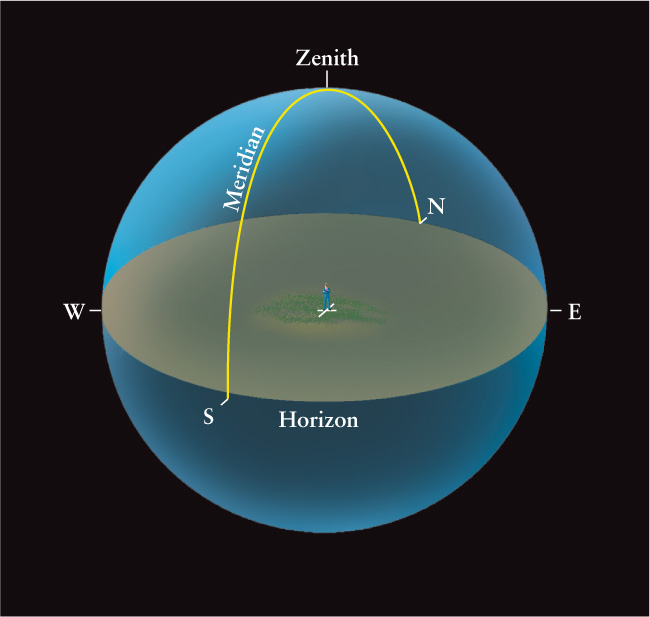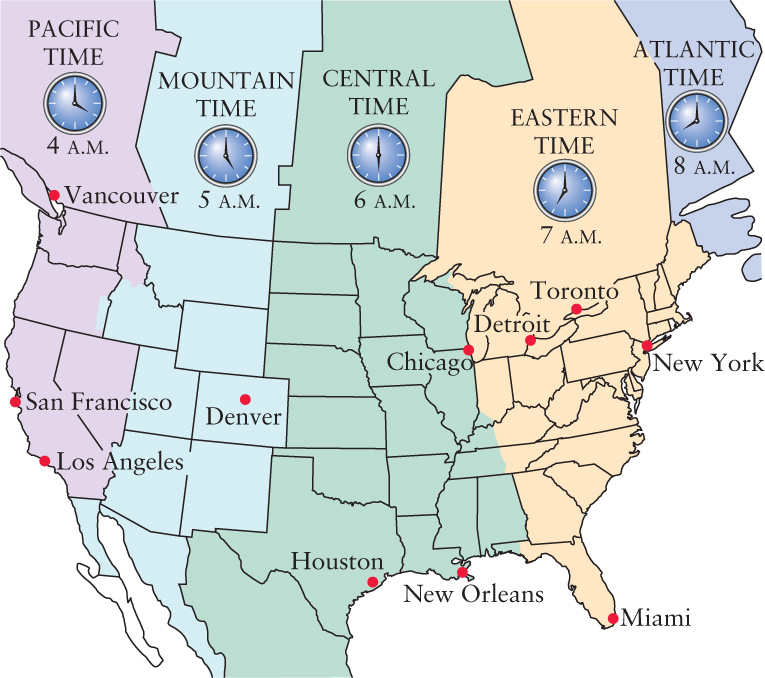2-7 Positional astronomy plays an important role in keeping track of time
Ancient scholars developed a system of timekeeping based on the Sun
Astronomers have traditionally been responsible for telling time. This is because we want the system of timekeeping used in everyday life to reflect the position of the Sun in the sky. Thousands of years ago, the sundial was invented to keep track of apparent solar time. To obtain more accurate measurements, astronomers use the meridian. As Figure 2-21 shows, this is a north-south circle on the celestial sphere that passes through the zenith (the point directly overhead) and both celestial poles. Local noon is defined as when the Sun crosses the upper meridian, which is the half of the meridian above the horizon. At local midnight, the Sun crosses the lower meridian, the half of the meridian below the horizon; this crossing cannot be observed directly.

The crossing of the meridian by any object in the sky is called a meridian transit of that object. If the crossing occurs above the horizon, it is an upper meridian transit. When an object makes a meridian transit, it is not necessarily at the zenith directly overhead, but is at the highest point above the horizon that you will see it from your location.
An apparent solar day is the interval between two successive upper meridian transits of the Sun as observed from any fixed spot on Earth. Stated less formally, an apparent solar day is the time from one local noon to the next local noon, or from when the Sun is highest in the sky to when it is again highest in the sky.
The Sun as a Timekeeper
Unfortunately, the Sun is not a good timekeeper (Figure 2-22). The length of an apparent solar day (as measured by a device such as an hourglass) varies from one time of year to another. There are two main reasons why this is so, both having to do with the way in which Earth orbits the Sun.

The first reason is that Earth’s orbit is not a perfect circle; rather, it is an ellipse, as Figure 2-22a shows in exaggerated form. As we will learn in Chapter 4, Earth moves more rapidly along its orbit when it is near the Sun than when it is farther away. Hence, the Sun appears to us to move more than 1° per day along the ecliptic in January, when Earth is nearest the Sun, and less than 1° per day in July, when Earth is farthest from the Sun. By itself, this effect would cause the apparent solar day to be longer in January than in July.
The second reason why the Sun is not a good timekeeper is the 23½° angle between the ecliptic and the celestial equator (see Figure 2-15). As Figure 2-22b shows, this causes a significant part of the Sun’s apparent motion when near the equinoxes to be in a north-south direction. The net daily eastward progress in the sky is then somewhat foreshortened. At the summer and winter solstices, by contrast, the Sun’s motion is parallel to the celestial equator. Thus, there is no comparable foreshortening around the beginning of summer or winter. This effect by itself would make the apparent solar day shorter in March and September than in June or December. Combining these effects with those due to Earth’s noncircular orbit, we find that the length of the apparent solar day varies in a complicated fashion over the course of a year.
To avoid these difficulties, astronomers invented an imaginary object called the mean sun that moves along the celestial equator at a uniform rate. (In science and mathematics, “mean” is a synonym for “average.”) The mean sun is sometimes slightly ahead of the real Sun in the sky, sometimes behind. As a result, mean solar time and apparent solar time can differ by as much as a quarter of an hour at certain times of the year.
Because the mean sun moves at a constant rate, it serves as a fine timekeeper. A mean solar day is the interval between successive upper meridian transits of the mean sun. It is exactly 24 hours long, the average length of an apparent solar day. One 24-hour day as measured by your alarm clock or wristwatch is a mean solar day.
Time zones were invented for convenience in commerce, transportation, and communication. In a time zone, all clocks and watches are set to the mean solar time for a meridian of longitude that runs approximately through the center of the zone. Time zones around the world are generally centered on meridians of longitude at 15° intervals. In most cases, going from one time zone to the next requires you to change the time on your wristwatch by exactly 1 hour. The time zones for most of North America are shown in Figure 2-23.

In order to coordinate their observations with colleagues elsewhere around the globe, astronomers often keep track of time using Coordinated Universal Time, somewhat confusingly abbreviated UTC or UT. This is the time in a zone that includes Greenwich, England, a seaport just outside of London where the first internationally accepted time standard was kept. (UTC was formerly known as Greenwich Mean Time.) UTC is on a 24-hour system, with no a.m. or p.m. In North America, Eastern Standard Time (EST) is 5 hours different from UTC; 9:00 a.m. EST is 14:00 UTC. Coordinated Universal Time is also used by aviators and sailors, who regularly travel from one time zone to another.
Although it is natural to want our clocks and method of timekeeping to be related to the Sun, astronomers often use a system that is based on the apparent motion of the stars. This system, called sidereal time, is useful when aiming a telescope. Most observatories are therefore equipped with a clock that measures sidereal time, as discussed in Box 2-2.